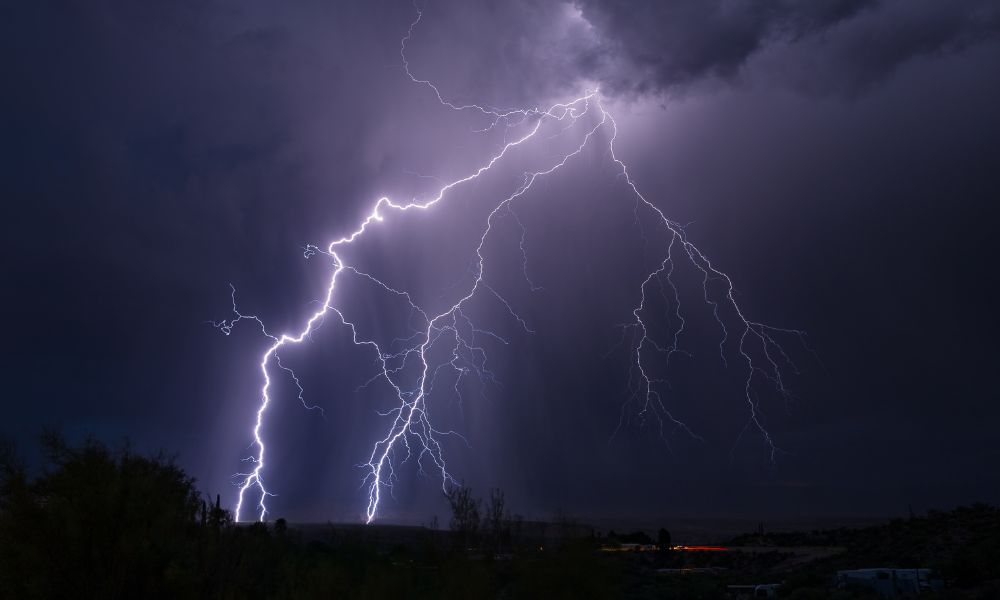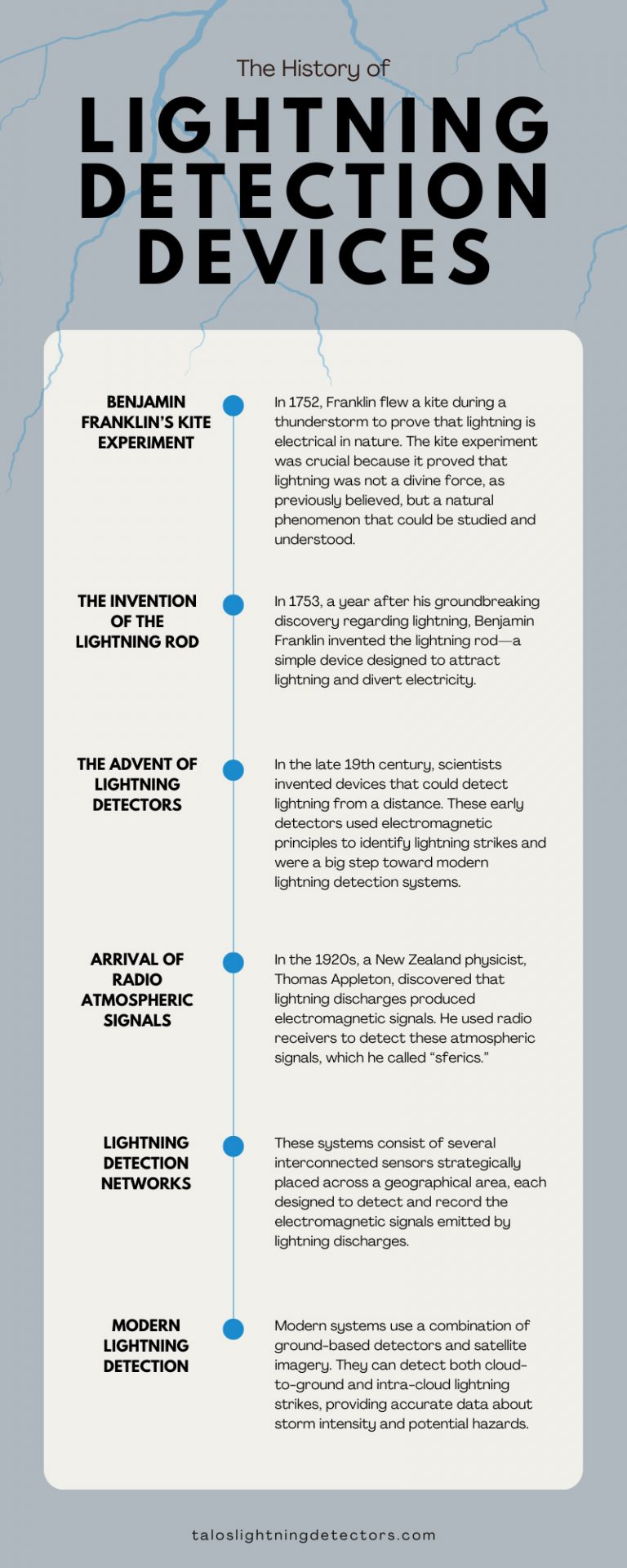The History of Lightning Detection Devices

Lightning events have been occurring on the face of the earth long before the rise of civilization. However, we only began studying and understanding lightning’s power in the 1700s. Ever since humanity’s early encounters with lightning, we’ve been both fascinated and fearful of this spectacular display of nature’s power. Through the years and with technological assistance, tracking lightning soon became more than just a means to view this natural occurrence—it became a form of awareness, prediction, and protection. Attempting to predict and understand these lethal phenomena led to the creation of various lightning detection devices over centuries.
Lightning detectors play a crucial role in today’s society, providing essential situational awareness regarding lightning threats. These technological advancements and detection systems benefit many industries, enhance an array of equipment and devices, and elevate the study of lightning.
Take a look back through the history of lightning detection devices and discover how such essential systems came to be and how lightning has affected societies through the years.
Early Concepts and Beliefs
Before actual studies of lightning came to fruition, many populations throughout history deduced lightning as a force beyond human understanding. Lightning detection was an identification of the works of divinity. Numerous ancient cultures perceived lightning as a manifestation of divine powers, often associating it with their deities.
The ancient Greeks believed lightning to be the weapon of Zeus, the king of the gods. Similarly, in Norse mythology, lightning was attributed to Thor, the god of thunder, who was said to strike his anvil with his hammer to produce lightning bolts. The Mayan civilization associated lightning with the god K’awiil, a deity of lightning, serpents, and fertility. In the Hindu belief system, the god Indra is the lord of lightning and thunderstorms, wielding the lightning bolt as his weapon. These mythologies underscore the awe and reverence humans have historically held toward the intense, unpredictable force of lightning and mark the beginning of lightning detection.
Benjamin Franklin’s Kite Experiment
The scientific study of lightning began earnestly in the mid-18th century when Benjamin Franklin conducted his famous kite experiment. In 1752, Franklin flew a kite during a thunderstorm to prove that lightning is electrical in nature. He attached a key to the kite string and waited for a lightning bolt to strike. When the bolt hit the kite, the electrical charge traveled down the string to the key, causing a spark.
The kite experiment was crucial because it proved that lightning was not a divine force, as previously believed, but a natural phenomenon that could be studied and understood. Knowing that lightning was electrical marked the pivotal first step in the scientific study of lightning, paving the way for the development of lightning detection devices in the following centuries. People began to understand what lightning was, providing insightful information on how to study, capture, and look for it.
The Invention of the Lightning Rod
The lightning rod, also known as a Franklin rod, came into existence shortly after Franklin’s kite experiment. In 1753, a year after his groundbreaking discovery regarding lightning, Benjamin Franklin invented the lightning rod—a simple device designed to attract lightning and divert electricity.
The working principle of a lightning rod was to operate on the understanding that electricity follows the path of least resistance. The rod is made of conductive materials, usually metal, which facilitates the easy flow of electrical charges. It’s installed at the highest point of a structure and is connected to the ground through a wire. When a lightning bolt strikes, it’s naturally drawn to the rod because of its high conductivity. The electrical charge then travels down the wire into the ground, where it’s safely dispersed. By providing a direct pathway, the lightning rod prevents the lightning bolt from passing through the building material, thus protecting the structure from damage.
The lightning rod offered the first mechanism through which the energetic and sporadic phenomena of lightning could be purposefully directed and studied under more controlled conditions. With a higher chance of attracting a lightning strike, researchers could observe the properties of lightning with a greater frequency and reliability than ever before.
The Advent of Lightning Detectors
Over time, Franklin’s discoveries and the research made possible by the lightning rod led to the development of early lightning detectors. These devices were initially simple, often just enhancements, like bell attachments, to the lightning rod itself that could indicate when a lightning strike had occurred.
In the late 19th century, scientists invented devices that could detect lightning from a distance. These early detectors used electromagnetic principles to identify lightning strikes and were a big step toward modern lightning detection systems.
Arrival of Radio Atmospheric Signals
In the 1920s, a New Zealand physicist, Thomas Appleton, discovered that lightning discharges produced electromagnetic signals. He used radio receivers to detect these atmospheric signals, which he called “sferics.”
The detection of these radio atmospheric signals became a fundamental method in lightning detection systems. By receiving and analyzing these signals, it is possible to determine the location and intensity of a lightning strike. The radio waves’ frequency, timing, and strength provide valuable information about the lightning’s characteristics and location.
Lightning Detection Networks
By the mid-20th century, lightning detection networks began to appear. Lightning detection networks represent a critical advancement in severe weather monitoring. These systems consist of several interconnected sensors strategically placed across a geographical area, each designed to detect and record the electromagnetic signals emitted by lightning discharges. The network’s sensors capture data regarding the characteristics of these signals, which are then used to triangulate the location of the lightning strike.
By analyzing the data from multiple sensors, these networks create a comprehensive, real-time overview of lightning activity across large regions. This not only helps in identifying storm patterns and progression but also assists in early warning systems to mitigate the risks associated with severe weather conditions.
Modern Lightning Detection
Modern systems use a combination of ground-based detectors and satellite imagery. They can detect both cloud-to-ground and intra-cloud lightning strikes, providing accurate data about storm intensity and potential hazards.
TALOS lightning detection devices use advanced technology and precise measurement solutions to collect accurate, real-time data on lightning occurrences up to 25 miles away. On top of just providing simple alerts, TALOS lightning detectors can monitor proximities, offering multiple alert warnings when lightning is at different critical distances.
The history of lightning detection devices has been a long one, starting from divine attribution to scientific understanding. Today, lightning detection technology is a crucial tool in weather forecasting, contributing to our safety and understanding of these powerful natural phenomena. With TALOS lightning detectors, you can count on the latest innovations in lightning detection.

Request a Quote
"*" indicates required fields
At TALOS, Engineering Drives Best-in-Class Quality
Our mission is to provide families with quality products that promote safety and awareness while enjoying leisure activities together. Our patent pending products feature the same technology used in expensive weather stations, but at a fraction of the price.
SHOP NOW
Don’t just take our
word for it.
At TALOS®️, we're developing that technology into new innovative concepts designed for enhancing consumer lifestyles.